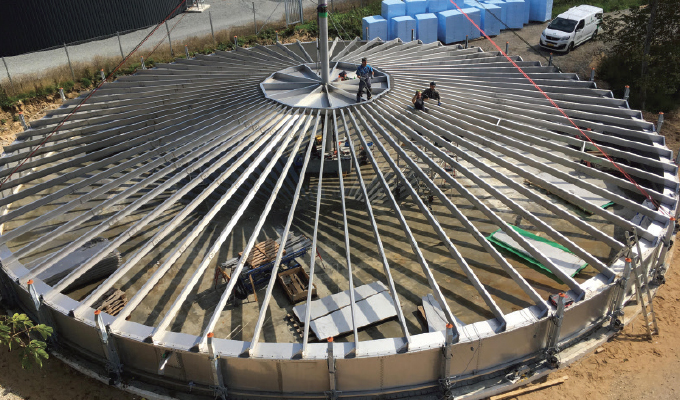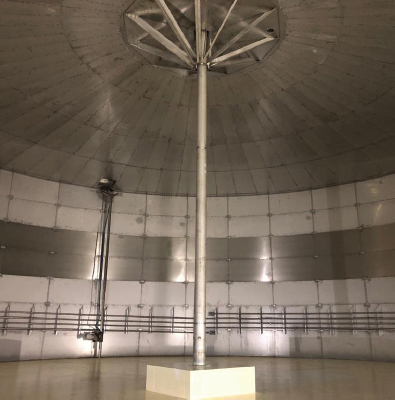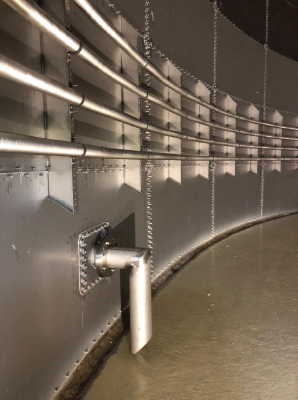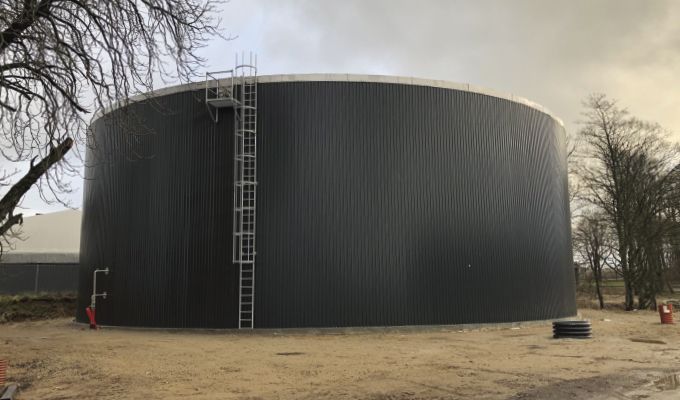By Benjamin Budde, Stallkamp
The biogas plant in Hammel near Aarhus can now consider its latest tank as the biggest glycerin tank in Denmark. It contains 1.1 million gallons of glycerin in a fully insulated digester made from long-lasting stainless steel.
THE TANK
The project is part of an existing biogas plant with a power of two megawatts. The diameter of the new biogas tank is 82 feet with a height of almost 30 feet. It is constructed with stainless steel shell plates in a segment-like design.
At the height of almost 30 feet, seven rings of the shell plates are necessary. The lower five rings are made from stainless steel 1.4462 and the upper two rings from stainless steel 1.4571 to prevent from corrosion.

THE ROOF
The digester is covered with a stainless steel roof pillared by a central support. Being composed of an inner and outer screwed element, the outer ring is attached to the top of the tank, whereas, the inner ring is posed higher. Thus, a decline of 10 degrees occurs. The roof is designed for insulation and cladding. It is completed by two inspection openings.

THE ACCESSORIES
Equipped with a heating system and full insulation it has the basic accessories of a digester. Moreover, the biggest glycerin tank in Denmark has two gas-tight wall bushings, two working platforms with ladders, and three powerful submersible motor agitators in stainless steel.
THE SUBSTANCE GLYCERIN
The basis for the fermentation process is glycerin with a pH value between 3.5 and 8. It is a waste from the production of biodiesel. Having a density of 10.8 pounds per gallon, the glycerin is heated up to 125.6 degrees Fahrenheit (52 degrees Celsius). Glycerin is considered to be the most valuable input for the fermentation process because the bacteria transform almost all of the glycerin. Thus, there are almost no fermentation residues. A comparison between the output of corn and glycerin illustrate the energetic value of glycerin. General guidance levels say that one ton of corn yields to 52,000-66,000 gallons of gas, whereas, glycerin yields to 264,000 gallons of gas.

THE CONSTRUCTION
The most crucial part of the project was the construction phase due to the enormous size of the tank. After the assembly of the first ring including the roof, the whole digester was electrically lifted up. Thirty-seven pillars were used to lift up the first ring and another four we needed to lift up the central support as well. Then the second ring was assembled and the tank was lifted several times until the seventh ring was constructed.
THE REASON WHY
It was a simple decision explains the plant owner. We have decided for stainless steel because it is the most durable material in terms of corrosion. And the decision for Stallkamp was easy as well. With the experienced and reliable distribution partner Biogas Teknik A/S, we knew that this project would going to be a success.

FOR MORE INFORMATION
Siemens Digital Industries Software, a business unit of Siemens Digital Industries, is a leading global provider of software solutions to drive the digital transformation of industry, creating new opportunities for manufacturers to realize innovation. With headquarters in Plano, Texas, and over 140,000 customers worldwide, we work with companies of all sizes to transform the way ideas come to life, the way products are realized, and the way products and assets in operation are used and understood. For more information, visit www.sw.siemens.com.
Benjamin Budde is head of sales for Erich Stallkamp ESTA GmbH. As a specialist in the design, manufacture and assembly of high quality, stainless steel products such as tanks, pumps, agitators, and separators, Stallkamp is the competent partner for the agriculture and wastewater industry all over the world. For more information, visit www.stallkamp.de/en.
MODERN PUMPING TODAY, September 2019
Did you enjoy this article?
Subscribe to the FREE Digital Edition of Modern Pumping Today Magazine!



